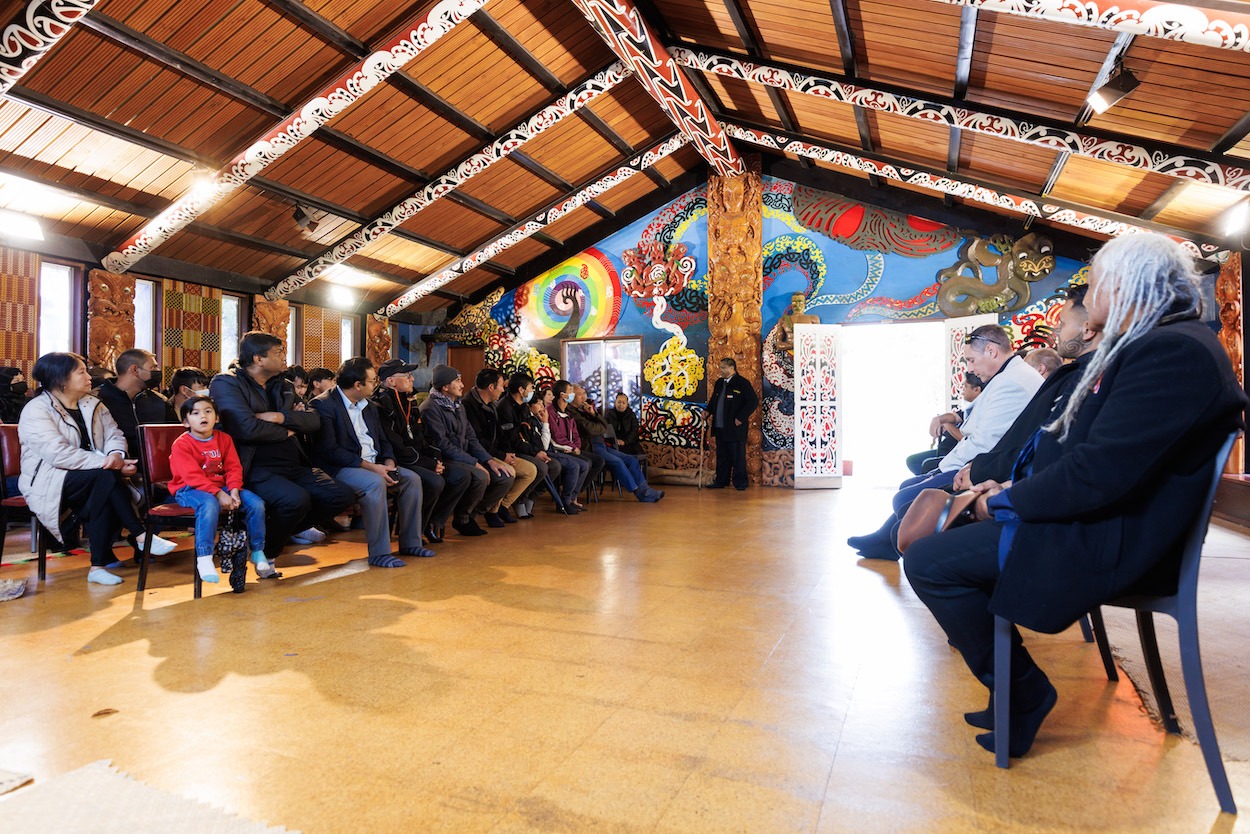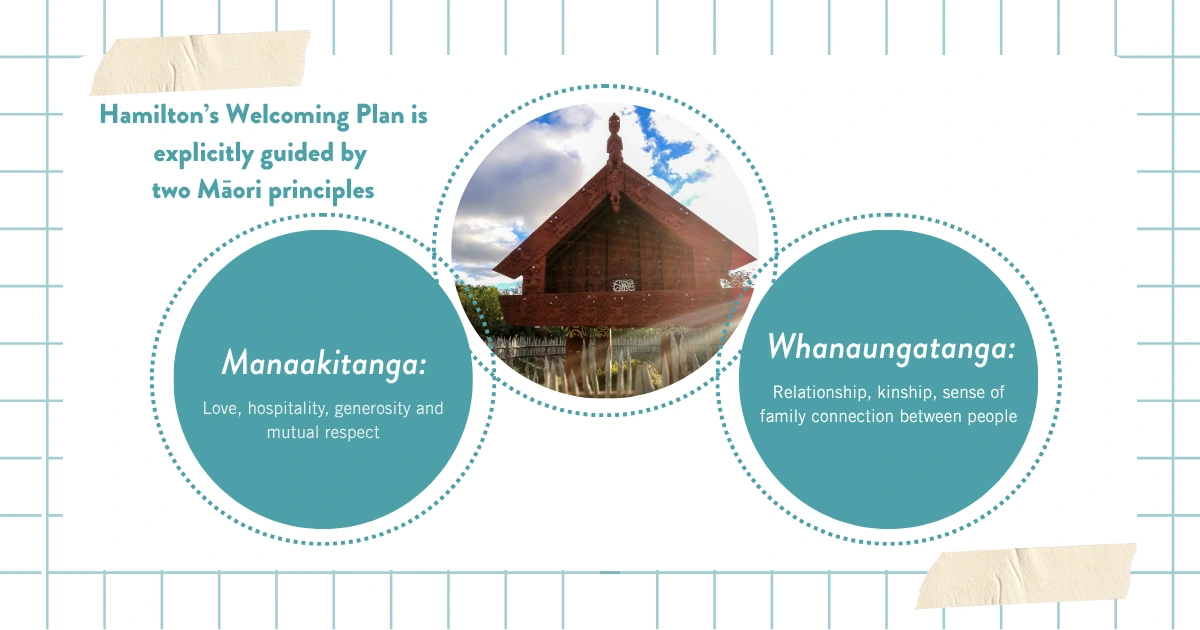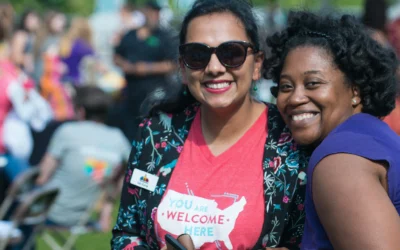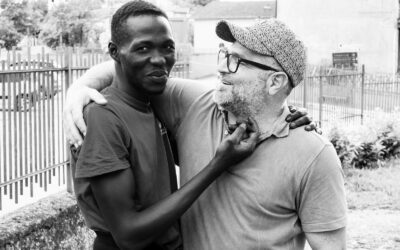
Photo from the 2022 Te Wiki o Maanaki Community Powhiri event held at Kirikiriroa Marae in Hamilton, Waikato, New Zealand. Credit: Mike Walen / KeyImagery Photography. Copyright: © Hamilton City Council.
Communities in New Zealand offer a lesson in what it means to truly welcome newcomers.
At the center of that work: partnerships with Māori tribes, guided by manaakitanga — a principle of love, hospitality, generosity, and mutual respect.
This Māori principle captures what it means to welcome and take care of each other. And it’s guiding communities across New Zealand to create more connected, inclusive places to live.
Collaboration with Māori tribes has become a cornerstone of New Zealand’s welcoming practices — it’s even embedded in the Welcoming Communities Standard, which calls for the intentional inclusion of New Zealand’s Indigenous peoples.
For Māori communities, partnerships affirm their identity and agency, making sure that they are active leaders in creating welcoming communities.
For everyone, including newcomers, building relationships matters because it acknowledges history, builds trust, and creates mutual understanding.
Māori Language Glossary
- Mana whenua: Historical and traditional land owners, including iwi (tribes) and hapū (sub-tribes).
- Tangata whenua: The indigenous Māori people of New Zealand, including iwi, hapū, and other hapori Māori (Māori communities).
- Iwi: Extended kinship group, tribe, nation, people, nationality, race — often refers to a large group of people descended from a common ancestor and associated with a distinct territory.
- Pōwhiri: A traditional Māori welcome ceremony that involves speeches, singing, and cultural performances to formally greet manuhiri (visitors) and establish respect and understanding.
Four ideas to partner with Indigenous communities to welcome newcomers
1. Prioritize Indigenous leadership and participation
Before Hamilton City Council joined New Zealand’s Welcoming Communities program, they reached out to the local hapū (sub-tribes in Hamilton) to request their support and endorsement. Local hapū didn’t just want to support the program — they wanted to partner with Hamilton City Council.
A few months after getting accepted to the Welcoming Communities program, representatives of local tribes signed the commitment document alongside the council representatives.
This was far more than a small gesture. All the communities involved had real agency to agree on how and why they were welcoming newcomers to Hamilton.
Today, Hamilton City Council’s Māori leadership team contains four Māori leaders — significant growth from one leader in 2022.
“I would emphasise the need to partner and work with tangata whenua, involving them in conversations early on. It’s still a work in progress in New Zealand and building connections continues to be a challenge, but I’m pleased that we have built — and continue to develop — these connections.”
2. Infuse local values
Hamilton’s Welcoming Plan is guided by two Māori principles:
- Manaakitanga: love, hospitality, generosity, and mutual respect
- Whanaungatanga: relationship, kinship, a sense of family connection
These values are specific to the local context and Indigenous culture, but also broadly shared by the community — respect, generosity, and family connect people across cultures. Looking for shared values helps bridge differences.

3. Weave in contemporary Indigenous cultural practices
Māori tribes in Tauranga shared that newcomers often have limited experience with contemporary Māori culture.
Local tribes, a community center, employers, newcomer community leaders and the events team at Tauranga City Council planned a cultural festival, weaving in pōwhiri (a traditional Māori welcome ceremony) at the beginning.
At this ceremony, newcomers experienced what it was like to be formally welcomed to Aotearoa — from the karanga (welcoming call) and whaikōrero (formal speeches) to waiata (songs) and kai (a shared meal).
“We want to share the value of Manaakitanga, which means welcoming and hospitality. When newcomers have the opportunity to experience welcome from the Māori, they feel a sense of belonging almost on a spiritual level.”
At some pōwhiri, like those hosted at Waiwhetu Marae in Lower Hutt, newcomers are encouraged to respond to the welcoming call and speech in their mother tongue. Translators support newcomers throughout the ceremony by explaining in English.
Welcoming Week is another way that events have brought together Māori traditions and newcomers’ cultures. Pōwhiri have been a powerful way for Indigenous tribes to welcome newcomers to their region during Welcoming Week – also known as Te Wiki o Manaaki.
4. Promote best practices through national networks
Welcoming Communities is a program of New Zealand’s national government and a partner in the Welcoming International Alliance. It’s leading the way on what it means to be truly welcoming in Aotearoa.
By embedding Indigenous partnerships into the national welcoming standard, local councils have the mandate and resources to build relationships with Māori tribes. National backing makes local action possible.
As a basis for collaboration, the Welcoming Communities team works with tangata whenua and councils to provide workshops about the Treaty of Waitangi. Either mana whenua or a partner called Tangata Tiriti – Treaty People will run these interactive learnings. Provided in multiple languages and plain English, newcomers better understand this important history of New Zealand and its Indigenous peoples, and how it impacts Māori communities today.
“Genuine consultation with tangata whenua builds trust, and in many cases, it is appropriate for them to lead while we collectively listen and learn. The importance of knowing the history of your Indigenous people is critical and creates a foundation for understanding. The more you understand them as a people — not just as a project or program — the better your relationship.”
As of October 2025, 35 councils – half of the country’s local councils, covering a third of New Zealand’s population – and 5 local boards are participating in the Welcoming Communities program.
Outside of New Zealand, more national networks and certification programs help local communities gain insight into best practices, including Welcoming Cities in Australia, the National LIP Secretariat in Canada, Welcoming America in the U.S., and ANVITA in France.
To learn more about how to create a national welcoming standard or certification program, check out the Welcoming International Guidelines for Standards.


